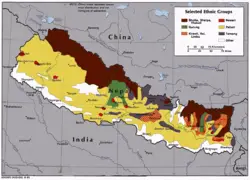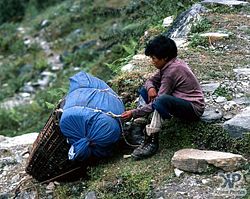Sherpa
The Sherpa are an ethnic group from the most mountainous region of Nepal, high in the Himalayas. In Tibet shar means East; pa is a suffix meaning 'people': hence the word sharpa or Sherpa. Sherpas migrated from eastern Tibet to Nepal within the last 500 years. Predominantly Buddhist, these people have forged an unusually close relationship with the English from the mountain climbing expeditions starting in the 1920's that has extended to most westerners. This has aided in the formation of many organizations to help the Sherpa environmentally, economically, in cultural preservation and many other ways.
The term "sherpa" (the preferred spelling with a lower case first letter) is also used to refer to local people, typically men, employed as porters or guides for mountaineering expeditions in the Himalayas. They are highly regarded as experts in mountaineering and their local terrain, as well as having good physical endurance and resilience to high altitude conditions. However, a sherpa is not necessarily a member of the Sherpa ethnic group.
History
The Sherpa originally came from eastern Tibet, crossing the Nangpa La pass at 5,900 m 19,200 ft. They settled in the Kumbu region known as the gateway to Mt.Everest to the south. Traditionally, they are the traders making the famous trans - Himalayan trade between Nepal and Tibet. They bring grains, cotton clothes, irons, paper from the south, and then bartering them for salt, wool, sheep and Tibetan artifacts in Tibet. They also have nomadic lifestyles herding yak, and some cultivate high altitude fields of potatoes, barley, wheat and buckwheat.
For centuries, the Sherpa carefully went around the mountains rather than traverse them, as they felt this was the residence of the gods and goddesses and it would be blasphemous to climb them. Mt. Everest in Tibetan is known as Qomolangma or Chomolangma, both meaning goddess mother. Probably the mutual respect that developed between the mountaineers helped them develop this skill and still be able to honor their gods.
Most Sherpas live in the eastern regions of Nepal Solu, Khumbu or Pharak. However, some live farther west in the Rolwaling valley and in the Helambu region north of Kathmandu. Pangboche is the Sherpas' oldest village in Nepal, and is estimated to have been built over 300 years ago. Some live near Namche Bazaar. The Jirels, native people of Jiri, are ethnically related to the Sherpas. It is said that the Jirels are descendants of a Sherpa mother and Sunuwar (another ethnic group of the eastern part of Nepal) father. In India, Sherpas also inhabit the towns of Darjeeling and Kalimpong and the Indian state of Sikkim. The 2001 Nepal Census recorded 154,622 Sherpas in that country, of which 92.83% were Buddhists, 6.26% were Hindus, 0.63% were Christians and 0.20% were Bön.
Culture
Sherpas speak their own Sherpa language which is in many ways a dialect of Tibetan. Traditionally (although not strictly followed), the names of Sherpa often reflect the day of the week on which they were born:
Ngi`ma (Ng' is the phoneme / ŋ /.) — Sunday
Dawa — Monday
Mingma — Tuesday
Lhakpa — Wednesday
Phurba — Thursday
Pasang — Friday
Pemba — Saturday
Sherpa society is organized according to exogamous clans. A hierarchical structure of society, such as is found among Nepal's Hindu castes, is quite foreign to the Sherpa. According to the traditional kipat system, by which a clan held exclusive communal rights over a large defined settlement and cultivation area, the whole Sherpa area was their clan land. Only members of the particular clan could hold land or reclaim the uncultivated land within the kipat jurisdiction, which included the streams and forests. The clan land was expropriated with the abolition of the kipat system in 1949.[1]
Before the influx of western influence, the Sherpas revered the Himalayas as a dwelling place of the gods and goddesses. For centuries, the very thought of climbing them was considered a blasphemy against the supernatural beings. Chomolungma is the Tibetan name for Mt. Everest, and is the dwelling place of Miyo Lungsungama, the goddess of humans and prosperity. When the Swedes, Germans, and Brittish first arrived at Mt. Everest, the allure of mountain-climbing for fame and monetary profit became of great appeal to the Sherpa, and they were highly praised and duly rewarded for their touchstone of high-altitude achievement. This was a radical shift in traditional culture, as the Sherpa had always maintained roles as traders and farmers, heavily emphasising their peaceful religious practices. The ancestral roles remain highly important to these mountain folk, but the climbing industry has become the staple of their economy.
Religion
Sherpa culture is vastly different from the other 50 ethnic groups of Nepal, including Hindus, Muslims and Buddhists. Throughout much of Nepal, Hindu and Buddhist doctrine has often meshed into a single ideology, whereas the Sherpa have adapted their beliefs from a series of different schools of thought and include the Tibetan animism. The Sherpa Buddhist teach of a spiritual understanding between all beings which is common in animistic religions. This also explains the hospitality and open acceptance of westerners as a natural aspect of Sherpa culture. Although they are pacifists, the Sherpa of Tibet are also known to be among the fiercest warriors. The guardian deity of the Sherpa is named Khumbu, which literally translates into "Khumbu country god."
Buddhism was probably brought to the Khumbu region towards the end of the 17th century by Lama Sange Dorjee, from the Rongbuk Monastery of the Nyingpa sect in Tibet. According to the legend, he flew over the Himalayas and landed on a rock at Pangboche and Thyangboche, leaving his footprints embedded on the stone. He is thought to have been responsible for the founding of the first gompas (monasteries) in the Khumbu region, at Pangboche and Thami. The gompas at Thyangboche and Namche Bazar were established at a later date. Every year, during the full moon of November-December, there is a festival with masks, costumes and ritualistic dances to celebrate the triumph of Buddhism over Bon, the ancient animistic religion of Tibet.
The Sherpa hungrily digest any and all tales and stories, and their oral traditions are passed on through the generations. Perhaps this is a quality that has helped foster the good relationship with westerners. A a famous story of Swedish missionaries illustrates the Sherpa attitude. The missionaries were traveling to Tibet as it opened to the west, and the Tibetans openly embraced tales from the bible, listening with intense intellectualism, questioning and debating amongst themselves. Although they were not converted, when the Tibetans were later questioned about their first encounter with the Christian missionaries, they responded with something to the effect of the missionaries being wonderful story-tellers.
Yeti
The Sherpa firmly believe in Yeti, the large, hairy human like creature that is the subject of much fascination and conjecture. The Yeti is featured in many folk stories and paintings. Many mountaineers have reported strange sightings and sounds that seem inexplicable, except for a creature like the Yeti. In 1974, one Sherpa girl was supposedly attacked by a Yeti while grazing her Yak. Several of the Yak had their necks broken, and she said the Yeti took them by the horns and twisted their necks.Cite error: Closing </ref> missing for <ref> tag
Two Sherpas, Pemba Dorjie and Lhakpa Gelu, have recently competed as to who can climb Everest from Basecamp quicker. On May 23 2003 Dorjie summitted in 12 hours and 46 minutes. Three days later, Gelu beat his record by two hours, summitting in 10 hours 46 minutes. On May 21 2004 Dorjie again improved the record by more than two hours with a total time of 8 hours and 10 minutes.[2]
On May 16 2007, Appa Sherpa successfully climbed Mt. Everest for the 17th time, breaking his own record for most successful ascents.[3]
Perhaps the most famous Nepalese female mountaineer, two-time Everest summiteer Pemba Doma Sherpa, died after falling from Lhotse on 22 May 2007.[4]
Notes
- ↑ Sherwa mi: Website on the Sherpas of Nepal Retrieved December 10, 2007.
- ↑ New Everest Speed Record upheld. EverestNews.com. Retrieved Feb 4, 2007.
- ↑ Super sherpa's new Everest record. BBC News (May 16, 2007). Retrieved May 16, 2007.
- ↑ "Famous female Nepal climber dead", BBC News, 23 May 2007
ReferencesISBN links support NWE through referral fees
- Norgay, Tenzing and James Ramsey Ullman. [1955] 2007. Man of Everest (also published as Tiger of the Snows) Gibson Square Books Ltd. ISBN 978-1903933312
- Ortner, Sherry B. 2001. Life and Death on Mt. Everest: Sherpas and Himalayan Mountaineering. Princeton University Press. ISBN 978-0691074481
- Tinzing, Judy, 2003, Tenzing and the Sherpas of Everest. Harper Collins e-books. ASIN B000FC143A
External links
- Website on the Sherpas of Nepal
- Website of United Sherpa Association in New York
- News: Sherpa breaks Mt Everest record - BBC
- The Sherpas National Geographic Magazine
- Sherpas — The Tigers of the Mountains
Credits
New World Encyclopedia writers and editors rewrote and completed the Wikipedia article in accordance with New World Encyclopedia standards. This article abides by terms of the Creative Commons CC-by-sa 3.0 License (CC-by-sa), which may be used and disseminated with proper attribution. Credit is due under the terms of this license that can reference both the New World Encyclopedia contributors and the selfless volunteer contributors of the Wikimedia Foundation. To cite this article click here for a list of acceptable citing formats.The history of earlier contributions by wikipedians is accessible to researchers here:
The history of this article since it was imported to New World Encyclopedia:
Note: Some restrictions may apply to use of individual images which are separately licensed.


